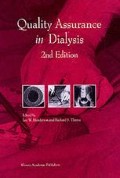Abstract
The role of quality assurance (QA) and continuous quality improvement (CQI) in the managed care of ESRD patients is closely linked with the ideas of evidence- based clinical practice and outcomes research. With concerns over rising costs in the treatment of ESRD patients, evidence-based clinical practice provides a mechanism whereby clinicians can choose a cost effective treatment or therapy for a group or subgroup of patients while optimizing select patient outcomes (e.g. improved patient survival, better quality of life, reduced patient hospitalization, etc.). This chapter provides some basic statistical principles, methods and models which clinicians can use in pursuit of evidence based clinical practice, quality assurance, CQI and/or outcomes research. Specific attention will be paid to the use of proper statistical methods for collecting, analyzing and summarizing patient-specific outcomes as they relate to a set of explanatory variables (i.e. independent variables or covariates).
Access this chapter
Tax calculation will be finalised at checkout
Purchases are for personal use only
Preview
Unable to display preview. Download preview PDF.
References
Twardowski ZJ, Nolph KD, Khanna R et al. Peritoneal equilibration test. Perit Dial Bull 1987; 7(3): 138–47.
Conover WJ. Practical nonparametric statistics, 2nd ed. New York: John Wiley & Sons, 1980.
Lehmann EL. Nonparametrics: statistical methods based on ranks. San Francisco: Holden-Day, 1975.
Friedman GD. Primer of epidemiology. New York: McGraw-Hill, 1974.
Monson RR. Occupational epidemiology. Boca Raton: CRC Press, 1980.
Breslow NE and Day NE. Statistical methods in cancer research, volume 1: the analysis of case-control studies. Lyon: IARC Scientific Publications No. 32, 1980.
Diggle PJ, Liang K.-Y and Zeger SL. Analysis of longitudinal data. Oxford: Clarendon Press, 1994.
Davidian M and Giltinan DM. Nonlinear models for repeated measurement data, 1st edition. New York: Chapman and Hall, 1995.
Vonesh EF and Chinchilli VM. Linear and nonlinear models for the analysis of repeated measurements 1st edition. New York: Marcel Dekker, 1997.
SAS Institute Inc. Master Index to SAS System Documentation, Version 6. 3rd edition. Cary: SAS Institute Inc., 1991.
Vonesh EF. Estimating rates of recurrent peritonitis for patients on CAPD. Perit Dial Bull 1985; 5:59–65.
Vonesh EF. Modeling peritonitis rates and associated risk factors for individuals on continuous ambulatory peritoneal dialysis. Stat Med 1990; 9:263 71.
Luzar MA, Coles GA, Faller B et al. Staphylococcus aureus nasal carriage and infection in patients on continuous ambulatory peritoneal dialysis. N Engl J Med 1990; 322:505–9.
Tranaeus A, Heimburger O and Lindholm B. Peritonitis during continuous ambulatory peritoneal dialysis (CAPD): risk factors, clinical severity, and pathogenetic aspects. Perit Dial Int 1988; 8:253–63.
Vonesh EF. Which statistical method to use when analyzing the incidence of peritoneal dialysis related infections? Perit Dial Int 1991; 11:301–4.
Holford TR. The analysis of rates and of survivorship using log-linear models. Biometrics 1980; 36:299–305.
Berry G. The analysis of mortality by the subject-years method. Biometrics 1983; 39:173–80.
Frome EL. The analysis of rates using Poisson regression models. Biometrics 1983; 39:665–74.
Fenton SSA, Schaubel DE, Desmeules M et al. Hemodialysis versus peritoneal dialysis: a comparison of adjusted mortality rates. Am J Kidney Disease 1997; 30:334–42.
Canada-USA (CANUSA) Peritoneal Dialysis Study Group. Adequacy of dialysis and nutrition in continuous peritoneal dialysis: Association with clinical outcomes. J Am Soc Nephrol 1996; 7:198–207.
Fleiss JL. Statistical methods for rates and proportions, 2nd edition. New York: John Wiley & Sons, 1981; 237–55.
Dean CB and Balshaw R. Efficiency lost by analyzing counts rather than event times in Poisson and overdispersed Poisson regression models. J Am Stat Assoc 1997; 92:1387–98.
Allison PD. Survival analysis using the SAS system: a practical guide. Cary, NC: SAS Institute Inc.. 1995.
Kaplan EL and Meier P. Nonparametric estimation from incomplete observations. J Am Stat Assoc 1958; 53:457 81.
Cox DR. Regression models and life tables (with discussion). J Royal Stat Society 1972; B34:187–220.
Kalbfleisch JD and Prentice RL. The statistical analysis of failure time data. New York: John Wiley & Sons, Inc.. 1980.
Malorca R, Vonesh E, Cancarini CG et al. A six year comparison of patient and technique survivals in CAPD and HD. Kidney Int 1988; 34:518–24.
Serkes KD, Blagg CR, Nolph KD, Vonesh EF and Shapiro F. Comparison of patient and technique survival in continuous ambulatory peritoneal dialysis (CAPD) and hemodialysis: a multicenter study. Perit Dial Int 1989; 10:15–19.
Maiorca R, Vonesh EF, Cavilli P et al. A multicenter selection-adjusted comparison of patient and technique survivals on CAPD and hemodialysis. Perit Dial Int 1991; 11:118–17.
Held PJ, Port FK, Turenne MN, Gaylin DS, Hamburger RJ and Wolfe RA. Continuous ambulatory peritoneal dialysis and hemodialysis: comparison of patient mortality with adjustment for comorbid conditions. Kidney Int 1994; 45:1163–9.
Wolfe RA and Strawderman RL. Logical and statistical fallacies in the use of Cox regression models. Am J Kidney Dis 1996; 27:124–9.
Nelson CB, Port FK, Wolfe RA and Guire KE. Comparison of continuous ambulatory peritoneal dialysis and hemodialysis patient survival with evaluation of trends during the 1980s. J Am Soc Nephrol 1992; 3:1147–55.
Nelson CB, Port FK, Wolfe RA and Guire KE. Dialysis patient survival: evaluation of CAPD versus HD using 3 techniques [Abstract]. Perit Dial Int 1992: 12:144.
Fisher LD, Dixon DO, Herson J et al. Intention to treat in clinical trials. In Peace KE, editor. Statistical issues in drug research and development. New York: Marcel Dekker, 1990.
Vonesh EF. Relative risks can be risky. Perit Dial Int 1993; 13:5–9.
Editor information
Editors and Affiliations
Rights and permissions
Copyright information
© 1999 Kluwer Academic Publishers
About this chapter
Cite this chapter
Vonesh, E.F. (1999). Choice of statistical models for assessing the clinical outcomes of the efforts to provide high quality care for the ESRD patient. In: Henderson, L.W., Thuma, R.S. (eds) Quality Assurance in Dialysis. Developments in Nephrology, vol 39. Springer, Dordrecht. https://doi.org/10.1007/978-0-585-28312-8_4
Download citation
DOI: https://doi.org/10.1007/978-0-585-28312-8_4
Publisher Name: Springer, Dordrecht
Print ISBN: 978-0-7923-5281-5
Online ISBN: 978-0-585-28312-8
eBook Packages: Springer Book Archive

